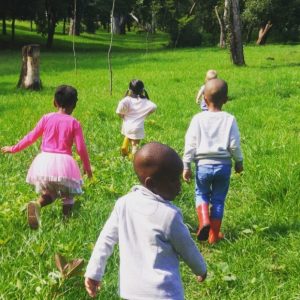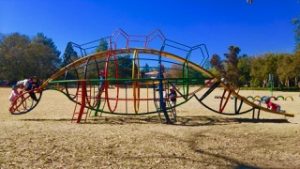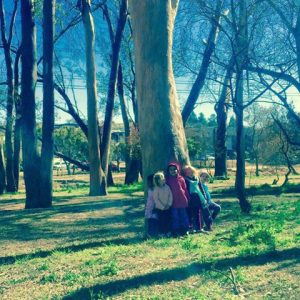The outdoors is the very best place for Preschoolers to practice and master emerging physical skills.
It is in the outdoors that children can fully and freely experience motor skills like running, leaping, and jumping. It is also the most appropriate area for the practice of ball-handling skills, like throwing, catching, and striking. Children can perform other such manipulative skills as pushing a swing, pulling a wagon, and lifting and carrying movable objects.
 Additionally, it is in the outdoors that children are likely to burn the most calories, which helps prevent obesity, a heart disease risk factor that has doubled in the past decade. With studies showing that as many as half of American children are not getting enough exercise– and that risk factors like hypertension and arteriosclerosis are showing up at age 5, parents and teachers need to give serious consideration to ways in which to prevent such health problems. The outside is also important because the outdoor light stimulates the Pineal gland, the part of the brain that regulates the “biological clock,” which is vital to the immune system, and makes us feel happier.
Additionally, it is in the outdoors that children are likely to burn the most calories, which helps prevent obesity, a heart disease risk factor that has doubled in the past decade. With studies showing that as many as half of American children are not getting enough exercise– and that risk factors like hypertension and arteriosclerosis are showing up at age 5, parents and teachers need to give serious consideration to ways in which to prevent such health problems. The outside is also important because the outdoor light stimulates the Pineal gland, the part of the brain that regulates the “biological clock,” which is vital to the immune system, and makes us feel happier.
Outdoor Play Contributes to Learning
The outdoors has something more to offer than just physical benefits. Cognitive and social/emotional development is impacted, too.
Outside, children are more likely to invent games. As they do, they’re able to express themselves and learn about the world in their own way. They feel safe and in control, which promotes autonomy, decision-making, and organizational skills. Inventing rules for games as preschoolers like to do promotes an understanding of why rules are necessary. Although the children are only playing to have fun, they’re learning:
- Communication skills and vocabulary as they invent, modify, and enforce rules.
- Number relationships as they keep score and count.
- Social customs learning to play together and co-operate.
Learning to Appreciate the Outdoors
We can’t underestimate the value of the aesthetic development promoted by being outside. Aesthetic awareness refers to a heightened sensitivity to the beauty around us. Because the natural world is filled with beautiful sights, sounds, and textures, it’s the perfect resource for the development of aesthetics in young children.
Preschoolers learn much through their senses. Outside there are many different and wonderful things for them to
- see: birds, green leafy plants
- hear: the wind rustling through the leaves, a bird’s song
- smell: fragrant flowers and the rain-soaked ground
- touch: a fuzzy caterpillar or the bark of a tree
Children who spend a lot of time acquiring their experiences through television and computers are using only two senses (hearing and sight), which can seriously affect their perceptual abilities.
Large, open outdoor facilities with trees, fresh grass, jungle gyms, sand play, trampolines, gardening activities etc. at your child’s preschool has endless benefits!





